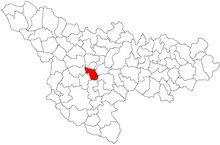Chișoda
|
Chișoda Altkischoda, Kischoda Tesöld, Kisoda |
||||
|
||||
| Basic data | ||||
|---|---|---|---|---|
| State : |
|
|||
| Historical region : | Banat | |||
| Circle : | Timiș | |||
| Municipality : | Giroc | |||
| Coordinates : | 45 ° 42 ' N , 21 ° 13' E | |||
| Time zone : | EET ( UTC +2) | |||
| Residents : | 2,004 (2002) | |||
| Postal code : | 307221 | |||
| Telephone code : | (+40) 02 56 | |||
| License plate : | TM | |||
| Structure and administration (status: 2004) | ||||
| Community type : | Village | |||
| Mayor : | Iosif-Ionel Toma ( PSD ) | |||
Chisoda ( German Alt-Kischoda , Altkischoda , Kischoda , Hungarian Tesöld, Kisoda ) is a village in the county Timis , Banat , Romania .
Geographical location
Chișoda is located in the middle of the Timiș District, south of the district capital Timișoara . To the east of Chișoda is the municipality of Giroc , and to the west the village borders on the VI. District of Timișoara Fratelia , the former New Kishoda.
Neighboring places
| Utvin | Timișoara | |
| Sânmihaiu Român |

|
Giroc |
| Say | Pădureni |
history
The first written mention of a village in the area of today's Chișoda dates from 1332 under the name Tesola . The place was completely destroyed during the Turkish invasions. The town was re-established during the Theresian Swabian procession between 1730 and 1760. The newly founded place was named Kisoda or Koschoda . The village of Kischoda is a typical German village with wide, chessboard-shaped streets.
As a result of the Austro-Hungarian settlement in February 1867, the Banat came under Hungarian administration internally . A huge wave of Magyarization began, which peaked at the beginning of the 20th century.
After the Banat was annexed to the Kingdom of Romania as a result of the Treaty of Trianon , Alt-Kischoda (1925) was one of the 13 chair district seats of what was then the Timisoara-Torontal district . Both Kischoda and Fratelia, but also Girok, had the rank of a community at that time, with their own local government.
As a result of the Waffen-SS Agreement of May 12, 1943 between the Antonescu government and Hitler's Germany , all men of German origin who were conscripted into the German army. Before the end of the war, in January 1945, all ethnic German women between 18–30 and men between the ages of 16–45 were deported to the Soviet Union for reconstruction work .
The Land Reform Act of March 23, 1945 , which provided for the expropriation of German farmers in Romania, deprived the rural population of their livelihoods. The expropriated land was distributed to smallholders, farm workers and colonists from other parts of the country. The collectivization of agriculture was initiated in the early 1950s . Through the nationalization law of June 11, 1948 , which provided for the nationalization of all industrial and commercial enterprises, banks and insurance companies, the expropriation of all economic enterprises took place regardless of ethnicity.
Since 1950 Kishoda has been a village without its own administration belonging to the municipality of Girok, and Fratelia is a district of Timișoara.
Demographics
| total | Ethnic structure | |||||||
|---|---|---|---|---|---|---|---|---|
| year | population | Romanians | German | Hungary | Others | |||
| 1880 | 1,187 | 1,078 | 90 | 4th | 15th | |||
| 1900 | 1,688 | 1,216 | 375 | 78 | 19th | |||
| 1910 | 3,007 | 1,223 | 969 | 768 | 47 | |||
| 1920 | 1,455 | 1,039 | 334 | 68 | 14th | |||
| 1941 | 1,602 | 1,114 | 356 | 97 | 35 | |||
| 1977 | 2,293 | 1,898 | 258 | 123 | 14th | |||
| 1992 | 1,829 | 1,640 | 72 | 80 | 37 | |||
| 2002 | 2,004 | 1,858 | 51 | 71 | 24 | |||
Personalities
- Ferdinand Christoph Heim (born April 27, 1932 in Chișoda), German caricaturist, painter and dialect author
See also
literature
- Elke Hoffmann, Peter-Dietmar Leber and Walter Wolf : The Banat and the Banat Swabians. Volume 5. Cities and Villages , Media Group Universal Grafische Betriebe München GmbH, Munich, 2011, 670 pages, ISBN 3-922979-63-7 .
Web links
- girocchisoda.com , official website of Chișoda
- arhivelenationale.ro (PDF; 1.0 MB), Archivele României, Primăria Chișoda
- banater-aktualitaet.de , Anton Zollner: Through former German villages of the Banat. Old Kishoda
Individual evidence
- ↑ kia.hu (PDF; 982 kB), E. Varga: Ethnic composition of the communities in Timiș County according to the censuses from 1880-2002
Remarks
- ↑ The new administrative division had the consequence that part of the municipality Chișoda Timișoara was incorporated, which explains the drastic decline in population.



